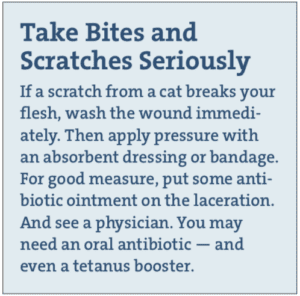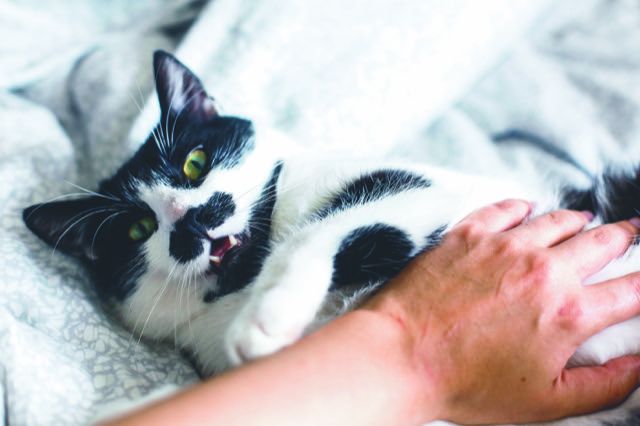Your cat does not bite or scratch out of nowhere, even though it may seem that way. Something is making her anxious enough to act out. And it’s not about wanting to spite you or being vindictive. That is, she has no scheme to make sure she hurts you. It’s simply an instinctual response to feeling upset. So don’t bother taking it personally when she does lash out, even though a bite or a scratch sure can hurt (as well as prove dangerous — wounds from a cat can cause a serious infection). Her aggression with her teeth or claws is simply what she uses in the moment because she doesn’t have words.
The best thing you can do is to stop a bite or scratch from happening in the first place. That means you will have successfully kept down your pet’s level of anxiety. But first you have to know the two main reasons your cat might get physically combative.
Pain. Just like people, cats have less emotional reserve when something is hurting them.  Any illness or other cause of pain can make them more reactive. Think of the way you might not want anyone trying to stroke you or even pay attention to you if you are, say, feeling nauseated.
Any illness or other cause of pain can make them more reactive. Think of the way you might not want anyone trying to stroke you or even pay attention to you if you are, say, feeling nauseated.
If you happen to touch the particular body part on your cat that’s causing the pain, she might become all the more reactive — even if she’s generally a gentle, easygoing soul. (Point it out to her doctor should you notice that touching a particular spot consistently makes your cat lash out.)
Fear. As with other animals (including people), fear can turn a cat aggressive. We tend to think of fear as an emotion that sends a cat under the bed or into a far corner. But it can also play out as self-protection in the form of scratching and biting. It can be a cat’s way of saying, “I’m scared; keep away.”
Sometimes what ignites the fear is not being touched but a loud noise or some other stimulus, like an unfamiliar cat outside the window. The cat can’t fix what’s upsetting her, so she directs her aggression toward you instead. “Redirected aggression is one of the most common reasons cats bite or claw people,” says the head of the Tufts Animal Behavior Clinic, Stephanie Borns-Weil, DVM. “Strangers in the home can also be frightening to a cat and may make her become aggressive,” Dr. Borns-Weil adds.
How to tell when the aggression is coming
So now you know that when a cat bites or scratches, it’s not because she’s being nasty. It’s because she’s had it and can’t cope. But you can help stop her from reaching the tipping point by recognizing the signs that she does not want your attention. Once you know them, you can take a preemptive step back — literally. That will allow your cat to stay calmer and feel more secure. Look for the following:
- Ears pinned rather than sticking up.
- Hard stare.
- Freezing in place.
- Twitching tail.
- Hissing.
- Snarling.
You will not calm a cat down once she is exhibiting any of these signs. The thing to do at that point is give her wide berth. In fact, if you are trying to pass from one room to another and a cat who has any of these signs is between you and where you want to be, step aside and let her pass — or reach your destination by going the long way around. The last thing you want is to make a cat who is already upset feel trapped or further threatened.





I have a female Bengal Abby that is 3yrs old. She is a very entertaining cat but she loves to chase after my husbands ankles and bites him! He is on blood thinners thus he bleeds easily.
She has no reason to be frightened or anxious as there is no other animal.. We think it is because she wants to play….
She could be anxious as she is a house cat and we live in Florida in the winter and she sees the geckos on the screens and she tries to get at them and can’t… Suggestions?
Maybe have a play session before she gets anxious’ perhaps 15 mins or so, to “wear her out”. Follow up with some petting or a treat.
One of my cats scratches me on the side my leg, when he wants a treat and I ignore him .
Meowrr! Once had a feral cat who didn’t like normal interactions-but I found a way around them. For holding her, I would let her just rest on my arm, & had a “designated hiding place” for stressful things (like the garbage truck, or the dogs who liked sniffing butts)
My female gets overly aggressive in play. Very sharp teeth. We are sure she does not mean to break skin. If she notices she has hurt us she runs away. We bought a set of welders gloves. She now gets excited when we take them out. She knows she is going to get to rough house with us. Everyone is happy
My newly adopted (3 mo ago) young female bengal loves humans and our dog but is terrified of my resident cats (or cats in general). Any sight or sound of them sends her into a fearful and angry frenzy and she wants to fight them and if I pull her away she redirects her anger at us or the dog. They ignore her and she only interacts with them through the crate. She has her own room, toys, playtime, time out when they’re away, scent exchange, etc but nothing helps. She sees them through glass door and wants to charge. Surely she’s been through bad experiences and Im not sure she will ever get over that.